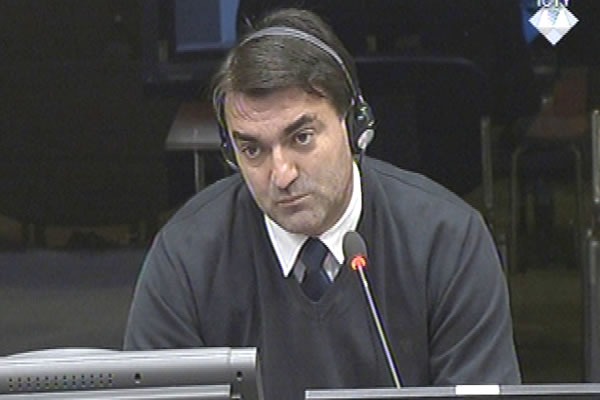Home
FROM VALJEVO VIA JAHORINA TO SREBRENICA
The court hears how a bank clerk from Valjevo ended up on the other bank of the Drina river among the Republika Srpska special units which took part in the VRS Srebrenica operation. Ratko Mladic’s defense notes that the police from the Republic of Serbia provided support to their colleagues from Republika Srpska in the preparation for the capture of the enclave. Srebrenica was formally under UN protection at the time
 Ljubodrag Gajic, defence witness at Rako Mladic trial
Ljubodrag Gajic, defence witness at Rako Mladic trial In July 1995, Ljubodrag Gajic, a bank clerk from Valjevo, citizen of the Republic of Serbia and reservist in the Yugoslav Army, found himself in Srebrenica against his will as part of the Republika Srpska special police. Ratko Mladic’s defense witness confirmed the prosecution’s allegation that the two police forces, from Serbia and Republika Srpska, ‘worked together closely’ to accomplish the ‘common goal’. Last week the prosecution put forth the argument in the cross-examination of Dragan Kijac, former head of the RS secret police.
At the beginning of his evidence today, Gajic described how the Serbian police knocked on his door in the night of 20 June 1995. They took Gajic to the Valjevo police station for an ‘interview’. From there the witness and other men who had been detained were taken by bus to the other side of the Drina river. In Zvornik, the witness and the others were handed over to the Republika Srpska police.
In the police station in Zvornik, Dusan Jevic Staljin, who was in the special police unit, addressed the men from Valjevo, calling them ‘deserters’. Staljin picked several of the men and assigned them to a special police formation. The men Staljin had chosen were taken to the training center on Mount Jahorina near Sarajevo. There the men went through intense tactical and combat training. Gajic protested several times, arguing that he had been unlawfully mobilized, or rather kidnapped, because he was a citizen of the Republic of Serbia, but to no avail. Gajic was called a deserter because he was born in Zavidovici, in Bosnia and Herzegovina.
On 11 July 1995, the day when Mladic’s troops entered Srebrenica, Gajic and about 150 or 200 trainees from the Jahorina center were transported to Eastern Bosnia. The men were told that they would take part in combat for the first time.
In the morning of 12 July 1995, the special police under the command of Goran Markovic, Mane Djuric and Dusko Jevic reached the so-called Yellow Bridge in Potocari. The Dutch Battalion of UNPROFOR did not offer any resistance at all, not even when Gajic’s unit took their observation post. This prompted the judges to ask the witness if the Dutch soldiers were allowed to move freely after the incident. Gajic replied that the situation was tricky because ‘they [the Dutch soldiers] were neither prisoners nor free men’.
In Potocari, Gajic saw Mladic address the gathered refugees. Mladic told the people that those who wanted to go to the BH Army territory would be taken there. Nothing bad would happen to anyone, Mladic also said. According to Gajic, the refugees cheered at Mladic’s words. The same reaction could be seen in the footage shown by the defense. Gajic didn’t see any Serb soldiers of police officers abuse the refugees. On the contrary, the refugees were given food and water and were assisted to board buses and trucks to go to Kladanj. Asked by defense counsel Stojanovic, the witness confirmed that the Dutch Battalion ‘was actively involved in the evacuation of refugees’.
The witness also confirmed that while the Bosniaks were put on the buses and trucks, the able-bodied men were separated from the women and children and taken to the ‘white house’ nearby. In front of the house the men had to throw away their personal belongings and documents. Gajic also confirmed that the UN soldiers protested to the VRS officers who were there against the overcrowding and inhumane conditions in which the men were held in the ‘white house’. The witness was told that the men would be exchanged. He didn’t know what happened to them. The witness’s unit left Potocari on 13 July 1995 at about 6pm and didn’t return there.
In the cross-examination, prosecutor Hasan was only interested in the whereabouts of Mladic’s witness in the night between 13 and 14 July 1995 and what he saw at that time. Gajic replied that they were woken up about an hour or two after midnight and taken to the warehouse at the farm in Kravica. In the dark, the witness could see the silhouettes of two soldiers: one of them was shooting at the people in the warehouse. According to Gajic, their task was to secure the road from Bratunac to Konjevic Polje. That night, the Srebrenica men who were moving in a column of towards Tuzla tried to cross the road. Two or three Muslims from the column surrendered to Gajic. The witness put them on a truck that took the detainees to the Kravica warehouse. Later he learned that the men from the Sekovici Brigade of the Republika Srpska special police had participated in the executions.
Next day, 15 July 1995, Gajic took part in the mop-up operation in the area from Kravica to Konjevic Polje. After that the witness was taken back to Jahorina. Gajic went home to Valjevo on 24 July 1995.
Linked Reports
- Case : Mladic
- 2015-10-22 MLADIC’S DEFENSE WITNESS PASSES AWAY
- 2015-10-22 DRAGAN KIJAC’S EVIDENCE INTERRUPTED
- 2015-10-21 ‘RUMORS’ ABOUT SREBRENICA GENOCIDE
- 2015-10-27 NO LINE OF SIGHT FROM SERB POSITIONS TO SNIPER VICTIMS
- 2015-10-28 OTHER SIDE RESPONSIBLE FOR SNIPER VICTIMS
- 2015-10-29 PROSECUTION CONTESTS MLADIC’S EXPERT METHODOLOGY
